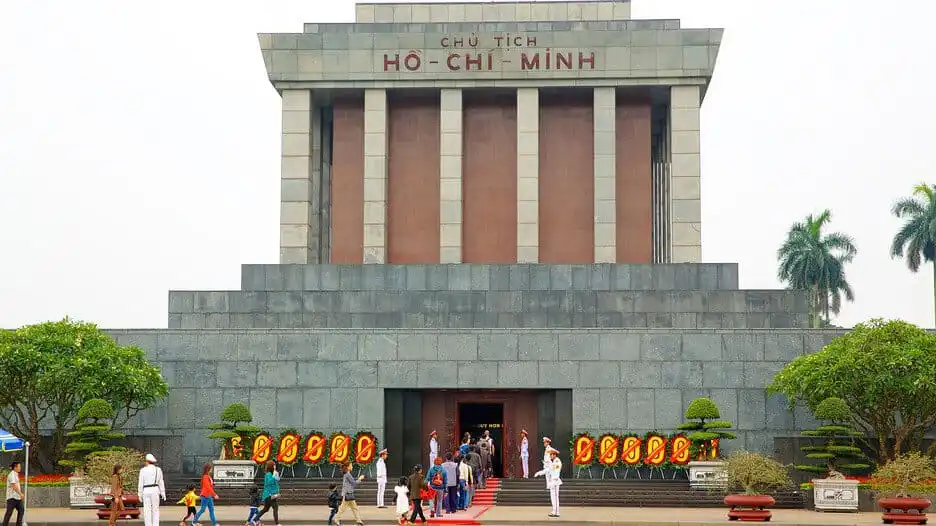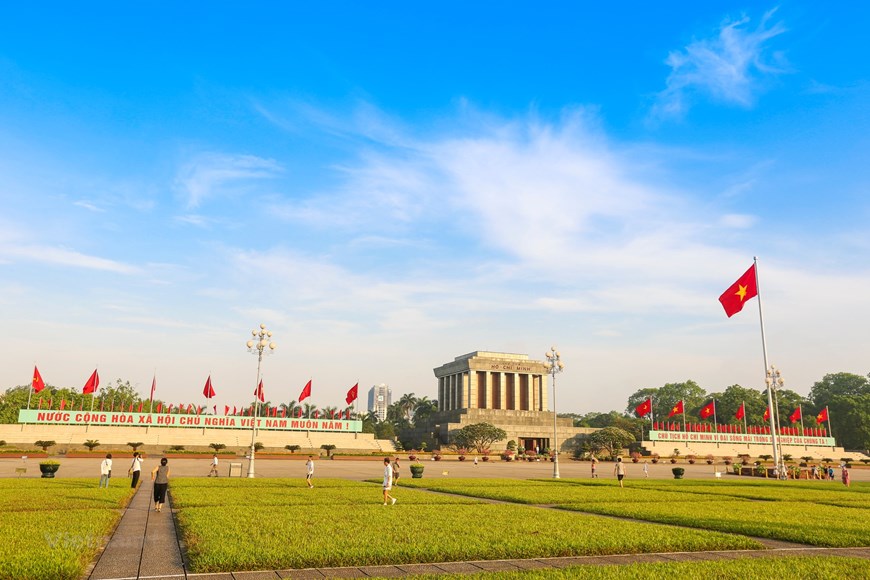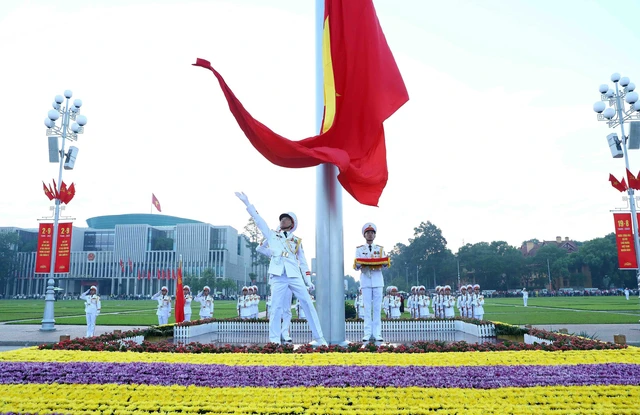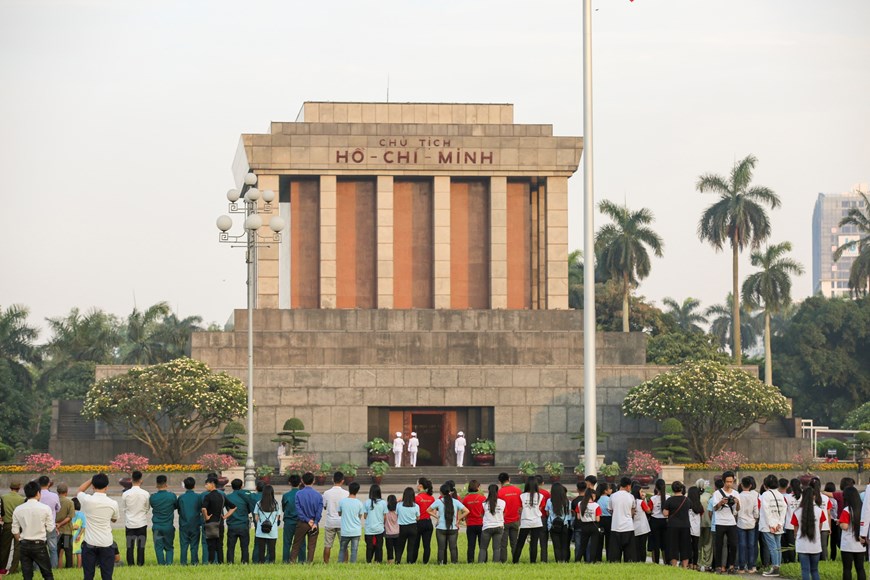Ho Chi Minh Mausoleum in Hanoi
Hanoi is considered Vietnam’s cultural, political, cultural, economic, commercial, and tourism center. Nature, as well as the historical relics here, are thousands of generations old. Remember to visit Uncle Ho Mausoleum – the ideal place to see that everyone needs to stay.
The landscape space of Uncle Ho Mausoleum is the convergence of the quintessence of architecture and cultural area of Hanoi Capital – the land of Thang Long thousand years of civilization, which is also the place where every Vietnamese and international visitor is looking forward to visiting once.
In addition to the Mausoleum and Ba Dinh Square, the architectural and landscape works here have both created a unified, tight, harmonious whole and ensured compliance with the common thought directed since the construction of the Mausoleum and renovation of Ba Dinh Square, which is to provide the “modern, ethnic, dignified and simple” to serve the requirements of long-term preservation best, absolute protection of President Ho Chi Minh’s body and organization of welcoming activities at the Mausoleum.
Several basic details on Uncle Ho’s Mausoleum

The construction of Uncle Ho’s Mausoleum began on September 2, 1973, and it was finished on August 29, 1975. This place is famous as the place to store the body of President Ho Chi Minh – the nation’s great leader. Ba Dinh Square, the President’s Palace, and Uncle Ho’s stilt residence are all located here.
The Mausoleum’s overall architecture is a solid square. The Mausoleum’s structure is built to be extremely strong, capable of withstanding floods, explosions, and earthquakes of magnitude 7.
The primary entrance of Uncle Ho’s Mausoleum is on the east side of Ba Dinh Square. The Mausoleum has three storeys and a height of 21.6 meters, making it a very high-level construction with a stage to serve many people’s remarkable activities, such as rallies. The middle part is extraordinary, including the corpse room, the corridor, and the stairs up and down. The upper part is a mausoleum shaped like a lotus flower. In front of the main Mausoleum, the words President Ho Chi Minh are set in ripe plum rubies.
The foyer is covered in red and pink marble, which serves as a backdrop for the words “Nothing is more precious than Independence and Freedom” and President Ho Chi Minh’s gold-plated signature. Two soldiers keep guard in front of the Mausoleum, changing guard every hour.
The door set in the Mausoleum is made of different gems and collected everywhere, so it is incredibly precious. The natural landscape surrounding the Mausoleum is lush, in harmony with over 250 plant varieties.
Operation hours, ticket prices

What days is Uncle Ho’s Mausoleum open? How much is your entrance ticket? Let Miti help you only solve those questions! To talk about opening hours, the Mausoleum will be divided into two seasons, including winter and summer. Winter shall be defined as the period from November to the end of March. Summer is expected to last from April to the end of October. Except on Mondays and Fridays, the Mausoleum is open every morning of the week. If there are holidays like New Year’s Day, National Day, or Uncle Ho’s birthday… coincide with Monday or Friday, Uncle Ho’s Mausoleum is usually open.
| Time | Open time | |
| Winter | Running day | 08:00 – 11:00 |
| Saturday, Sunday, Public Holiday | 08:00 – 11:30 | |
| Summer | Running day | 07:30 – 10:30 |
| Saturday, Sunday, Public Holiday | 07:30 – 11:00 | |
The ticket price to Uncle Ho’s Mausoleum will be completely free; if you are a foreigner, the ticket price to visit Uncle Ho’s Mausoleum is 25,000 VND/ person, and the ticket to enter the stilt house is 25,000 VND/ person.
Guide to Uncle Ho’s Mausoleum
When entering the gate of Uncle Ho’s Mausoleum, you will be managed by the Mausoleum to guide the way as well as how to arrange how to enter. When inside, you should pay attention not to take pictures and not make noise and do not forget to leave the phone in silent mode. After visiting Uncle Ho’s Mausoleum, proceed to the Presidential Palace and Uncle Ho’s fish pond to stay together.
Directions to Uncle Ho’s Mausoleum
It is impressive because it is planted with many trees, ancient trees, and has a vast campus. The swimming fish includes a variety of colors that are fluttering under the lake. Indeed, when you come here, you will have the experience of the open space, which is pleasant and highly airy. Visiting Uncle Ho’s Stilt House – this place displays the artifacts of his life, including the items in the process of making the Revolution. It would help if you queued in order and did not touch the artifacts.
Ho Chi Minh Museum is the next place where we come to the extremely lively artifacts and documents, such as a miniature history of the life of people and people of President Ho Chi Minh. When you reach the museum, remember to visit One Pillar Pagoda in the Ly period to learn about this unique temple’s architecture! One Pillar Pagoda is a symbol of the city and is known as Hanoi’s thousand-year-old lotus, so if you come here, make sure to visit this temple to see its beauty for yourself.
Flag raising ceremony, flag lowering ceremony

In addition, if you go in time to raise or lower the flag, you will be completely honored to witness the most prestigious dress ceremony in the country. The flag-raising ceremony is a national ceremony performed at 6 a.m. every day in front of the President’s Mausoleum. The flag-raising delegation leaves behind President Ho Chi Minh’s Mausoleum. At the head of the flag is the Determined to Win pennant. After that, there was a demobilization team with 34 people, symbolizing the first 34 soldiers of the Vietnamese team to propagandize the liberation of the army. To reach the foot of the flagpole, the group marched around to the front to the sounds of the song “Progress under the Military”.
Three soldiers in the red flag will advance towards the flagpole to prepare the flag-raising rituals. At this point, the President’s door began to open. When the flag is ordered to be launched and flown during the National Anthem, it is raised to the top of the flagpole. After raising the flag, the soldiers concluded the ceremony by walking around in front of Uncle Ho’s Mausoleum.
Every day at 21:00, the flag-lowering ceremony is performed, with a routine similar to the flag-raising ceremony. To preserve the image of the national flag, the soldiers conduct the flag salute ritual in the most solemn and reverent manner possible. These rituals are more religious than ever on special holidays such as Independence Day and Uncle Ho’s birthday.
A few notes when visiting Uncle Ho’s Mausoleum

- When you come to Uncle Ho’s Mausoleum, please pay attention to dressing seriously and politely by wearing long pants over the pillow, and do not wear shorts or offensive costumes.
- Behaviors and attitudes: Behave in a civilized and polite manner, do not cause disorder and affect those visiting. Pay attention to go lightly, speak quietly, and line up in order.
- Age not allowed to visit Uncle Ho’s Mausoleum: Under 3 years old.
- Regulations before visiting Uncle Ho’s Mausoleum: It is necessary to send luggage following the regulations, not to send electronics, jewelry, metal items, or food that are not allowed to be sent.

